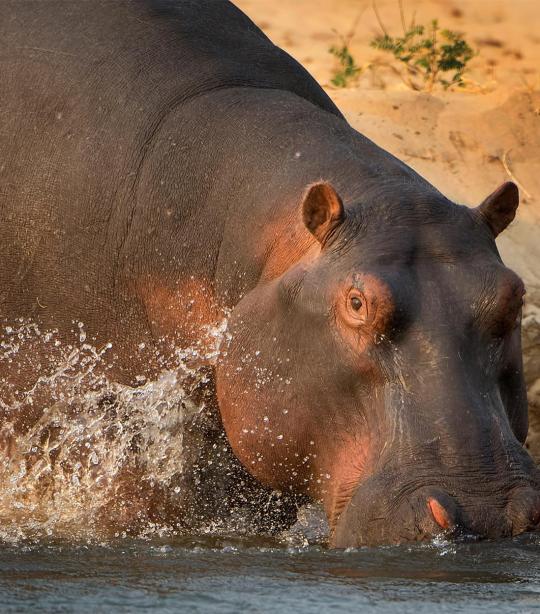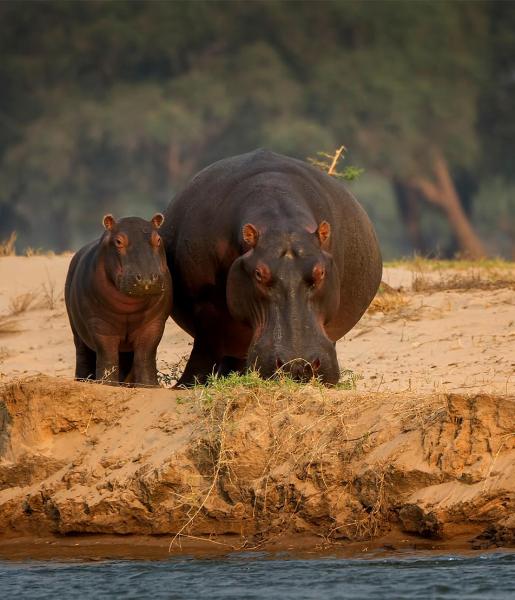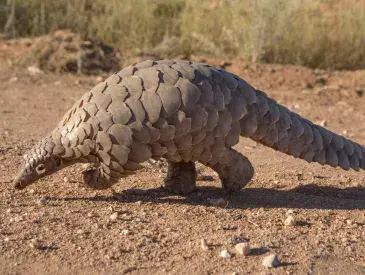What is a hippo?
There are two species of hippos — the large/common hippo and the smaller relative, the pygmy hippo. Hippos are the third-largest living land mammal, after elephants and white rhinos. Despite their large and bulky appearance, they have adaptations to their semi-aquatic environments allowing them to move swiftly on both water and land. Their feet have four-webbed toes that splay out to distribute weight evenly and therefore adequately support them on land, and their short legs provide powerful propulsion through the water. The pygmy hippos digits are more spread out and have less webbing and, proportionally, their legs are longer relative to its body size. They both have skin tones of purple-gray or slate color, with brownish-pink coloring around their eyes and ears. They have very thick skin that is virtually hairless except for the thick bristle-like hair on their heads and tails. The outer layers of skin are quite thin, making them prone to wounds from fighting. Their flat, paddle-like tail is used to spread excrement, which marks territory borders and indicates status of an individual. Their powerful jaws are capable of opening up to 150 degrees revealing their enormous incisors.
Hippopotamus amphibius: Common Hippo; Choeropsis liberiensis: Pygmy Hippo
Common Hippo: 1.4 to 5 tons; Pygmy Hippo: 160 to 275 kilograms (352-606 pounds)
Common Hippo: 2 to 5 meters in length (6 to 16.5 feet) and stand about 1.5 meters tall (5 feet); Pygmy Hippo: 1.5 to 1.75 meters in length (about 5 feet) and stand about 1 meter tall (3 feet)
Up to 50 years in the wild
Wetlands, rivers, and swamps
Herbivorous
Common Hippo: Average 10 months; Pygmy Hippo: Average 6.5 months
Humans, lions, crocodiles, hyenas

Challenges
Hippopotamus populations are threatened by hunting.
Hundreds of hippos are shot each year to minimize human-wildlife conflict, despite the fact that ditches or low fences easily deter them. It is more likely that the popularity of their meat is the reason for this strategy. Their fat and ivory tusks are also valuable to humans. At the beginning of the 21st century, the population of the common hippo declined more than 95 percent in the Democratic Republic of the Congo. In 2002, about 5.5 tons of hippo teeth were exported from Uganda, which equates to an estimated 2,000 individual animals. Hippopotamus teeth have been excluded from many of the strengthened ivory bans now spreading across the world making this vulnerable species at an increased risk from ivory poachers.
While the pygmy hippo is not generally a primary target for subsistence hunting, they are reported to be hunted opportunistically by bushmeat hunters.
Humans are pushing hippos out of their habitats.
As human populations grow, they encroach on wildlife habitats as they build new settlements, increase agricultural production, and construct new roads. The hippopotamus once ranged from the Nile Delta to the Cape, but now is mostly confined to protected areas. The primary threats to both hippopotamus species are habitat loss and deforestation.
Solutions
Our solutions to conserving the hippopotamus:
African Wildlife Foundation helps communities build enclosures, fences, and construct ditches to protect agriculture and farmland from grazing hippos, thereby minimizing human-wildlife conflict.
We strengthen and protect the hippo’s habitat by providing funding and improving infrastructures of parks, such as the Lower Zambezi National Park. Located along the Zambezi River, Lower Zambezi National Park is a critical habitat for hippos, elephants, African wild dogs, cheetahs, and more.


Behaviors
Unlike us, the hippopotamus does not have sweat or sebaceous glands.
Both species rely on water or mud to keep cool — this accounts for the amount of time they spend in the water. Instead of sweating, they secrete a viscous red fluid, which protects the animal’s skin against the sun and possibly acts as healing agents.
Their social structures are dependent on food and water conditions.
These animals have a flexible social system. Common hippos are usually found in mixed groups of anywhere from 20 to 100 individuals held by a territorial bull, but in periods of drought large numbers are forced to congregate near limited pools of water. This overcrowding disrupts the hierarchical system, resulting in even higher levels of aggression, with the oldest and strongest males asserting dominance. Old scars and fresh, deep wounds are signs of daily fights. Unlike their social cousins, pygmy hippos are solitary and aren’t territorial. If they encounter each other outside of mating, then they simply ignore each other.
Diet
The surprisingly agile hippo climbs steep banks each night to graze on grass.
They leave the water pool at night to graze for four to five hours, covering up to eight kilometers (five miles) of territory. They will eat about 40 kilograms (88 pounds) of food during this time. Their modest appetite is due to its sedentary life, which does not require high outputs of energy. When returning from grazing before dawn, they will enter their water pool at the same spot they exited.
Habitats
Where do hippopotamuses live?
Two hippo species are found in Africa. The common hippo (also known as the large hippo), found in East Africa, occurs south of the Sahara. The other much smaller species of hippo is the pygmy hippopotamus. Limited to very restricted ranges in West Africa, it is a shy, solitary forest dweller, and is now endangered.



